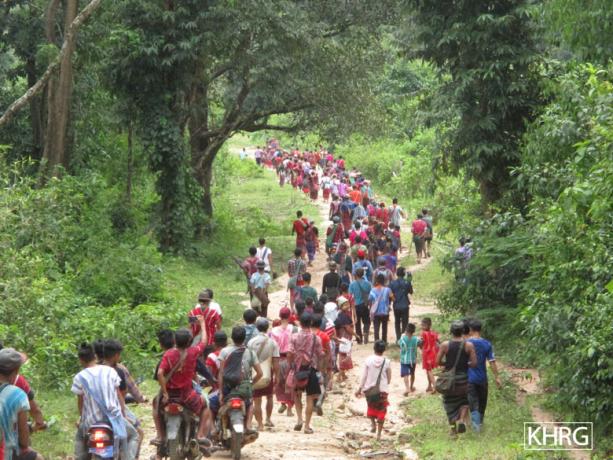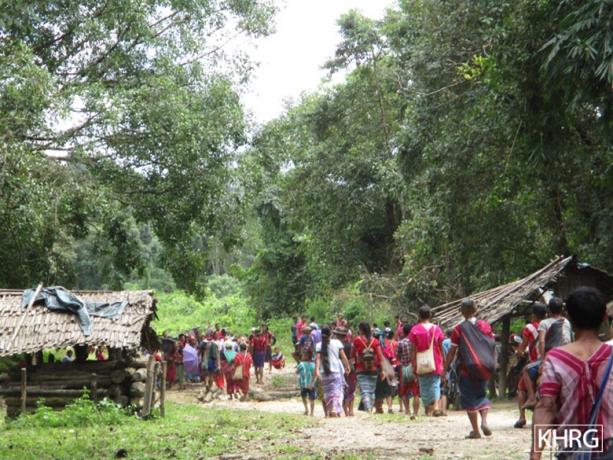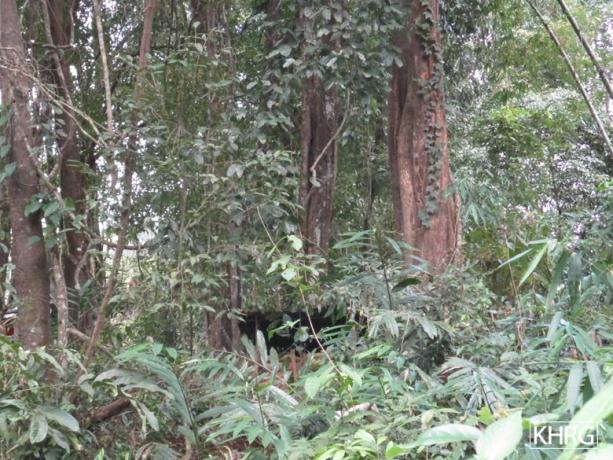Since February 2019, the Tatmadaw[1] has been conducting road construction activities in Kleh Der village tract, Kyaukkyi Township, Kler Lwee Htoo [Nyaunglebin] District. Because of the increased Tatmadaw presence in the area, villagers now feel unsafe and are afraid to travel. The road construction activities have also resulted in displacement and sporadic skirmishes between the Tatmadaw and the Karen National Liberation Army [KNLA].[2] Although road works were halted during the rating season [May to October], the Tatmadaw maintained a strong presence in the area and kept conducting reconnaissance activities. In October and November 2019, villagers from several village tracts held demonstrations to call for the cessation of road construction activities and the demilitarisation of the area, to no avail.[3]
Tatmadaw activities in Htoh Hkay Poo village tract
In 2016, internally displaced persons [IDPs] returned to their area of origin in Y--- village, Htoh Hkay Poo village tract, Shwekyin [Hsaw Htee] Township. They fled the village in the past because of the fighting between armed actors, mostly the Tatmadaw and the KNLA. There are now 52 houses in that village. A local community member told KHRG about the problems and human rights violations the villagers were facing.
In 2016, the Tatmadaw built an army camp near the village after the villagers returned. It was built with bricks. Since then, the villagers have been facing troubles because of the Tatmadaw soldiers. Villagers now have to inform the soldiers about their activities. If they fail do to so, the Tatmadaw soldiers threaten them. This obligation to inform them [about their activities] became like a job [a daily responsibility].
There is a Tatmadaw checkpoint at the entrance of Y--- village. Outsiders passing through the checkpoint on bullock carts and motorbikes must pay 1,000 and 500 kyats [USD 0.77 and 0.38],[4] respectively.
In April 2017, during the water festival, a Tatmadaw soldier from Light Infantry Battalion [LIB] #598 was drunk. He [wanted] local young people to share a meal with him at 12 am, but they were asleep. The soldier got angry when local people suggested him to invite these young people in the morning [dealing with Tatmadaw soldiers is often a source of anxiety for Karen villagers, especially when these soldiers are drunk or losing their temper].
In 2017 [KHRG was not able to establish the exact date], two Tatmadaw soldiers from LIB #598 walked into a wedding ceremony. They got drunk and had an argument with a local young man because they were not served food. Then, they got angry at the village head and fired their guns two times, leaving villagers frightened.
In 2018, schoolchildren participated in the 'Kathina' ceremony [a Buddhist celebration usually held in October or November] at the local primary school. After the ceremony, two drunken Tamadaw soldiers from LIB #603 walked into the school. They gave snacks to the children and tried to forcibly carry them. Some children took the snacks, and some cried. The teachers felt that this was inappropriate. The two soldiers gave snacks to U Than Win’s five-year-old daughter, O---, and followed the girl to her home. Two teachers noticed it and followed these two soldiers. In the end, nothing happened [to the girl].
One local villager stated: “We are afraid of the Tatmadaw soldiers. As civilians, we would like to live independently. We do not want any army camp based in our village. These soldiers are violating our rights.”
Impact of the Tatmadaw road construction activities on villagers
The villagers from A---, Kheh Der village tract had to flee from their village [in the past] because of the tensions [fighting]. They returned to their village in 2014 after the local security situation improved. In February 2019, the Tatmadaw started building a road near the village. As a result, 108 villagers had to displace again [and relocate in a nearby forest].
Because of the [Tatmadaw] road construction activities, local villagers are afraid and full of worry. The road works also resulted in commuting difficulties, as villagers are too scared to go and work on their farms [because of the presence of Tatmadaw soldiers]. However, some villagers have to take risks and travel for their family livelihoods, especially breadwinners who now travel in groups. Children and older villagers do not travel without guardians anymore. Some villagers were so afraid that they chose to stop travelling. Therefore, they face restrictions to their freedom of movement because of this situation. The road construction works also resulted in the destruction of villagers’ water pipes [and in difficulties to access clean water].
The presence of Tatmadaw soldiers also impacted access to education and healthcare. In Kheh Der village tract, the students who attend [primary] school in other villages are afraid of travelling near the Tatmadaw bases in A--- village, E---, B---, W---, D---, T--- and R--- places. The students from A--- village who attend middle school or high school in other villages such as H---, U--- and M--- faced similar issues. Their parents think that it is not safe for their children to travel to their schools, so they had to stop attending school.
In 2019, when skirmishes broke out between the Tatmadaw and the Karen National Liberation Army [KNLA] because of the Tatmadaw military road construction activities, some students from H--- village could not sit for the first semester exams in February. Villagers heard that the KNU [Karen National Union][5] school in H--- village was negotiating with other [Myanmar government] schools close to Kyaukkyi town so its students could take the exam [that would allow them to pursue their education in Myanmar government schools]. However, the students were not able to take the exam. The H--- school teachers asked them to take it, and the village leaders also informed the parents about it. But the parents were too worried about the security of their children to let them go and take the exam.
Regarding healthcare, villagers from A--- were planning to build a clinic. However, healthcare workers are too afraid of staying [in the village] because of the Tatmadaw soldiers based nearby [so they did not build it]. Villagers now have to take risks [travel in front of six Tatmadaw camps] to access healthcare services [at the Ler Doh hospital] because they do not have other options.
So far, there have been no instances of human rights violations by the Tatmadaw against villagers on their way [to the clinic or schools]. However, we [villagers] are afraid and traumatised because of our past experiences [because of the Tatmadaw’s long history of subjecting civilians to human rights abuses].
There are eight Tatmadaw army camps [five new ones and three old ones] between N-- village and where the IDPs from A--- village have relocated. They are located in A--- village, E---, W---, D---, T---, R--- places and in two other locations near Aee Tha Plaw [one close to the village and another one near the road]. All the Tatmadaw camps are located near the vehicle road, and the five battalions manning them rotate regularly. Tatmadaw soldiers also patrol the road, which creates security concerns among villagers. Because some of the villagers’ farms and plantations are located beside the road, the villagers do not feel safe to work on their lands to secure their livelihoods anymore.
Saw P--- was shot at by Tatmadaw soldiers on May 1st 2019 while he was looking for his buffaloes [the incident happened in Kheh Der village tract, but KHRG was not able to establish the exact location]. Fortunately, the bullet did not hit him so he was able to escape. Later that month, he encountered Tatmadaw soldiers on his way to the bridge to look for his buffaloes, so he stopped his trip and returned home [to protect himself from any potential harm].
Another villager who was pointed at with guns by the Tatmadaw soldiers was [Saw][6] I---. It happened on August 2019 when he was on his way to C---village with his wife and a child he was carrying. They encountered Tatmadaw soldiers and two of them pointed their guns at him. During this incident, he said he was very concerned and afraid, but he could not do anything so he thought that the Tatmadaw would just kill him. Fortunately, the Tatmadaw soldiers passed through him [without further incident]. However, he decided to return home because he was too afraid to continue his trip.
Reconnaissance activities by the Tatmadaw
The local population [IDPs from A---, Kheh Der village tract] saw Tatmadaw drones on several occasions. Community members noted the incident dates in their notebooks. One drone fell on the roof of one house belonging to an IDP from A--- on April 10th 2019 at 4 am. When the villagers heard the sound [of the drone] above their house, they got scared and did not even feel safe enough to go out and check. After a while, they got out of the house and then they saw that drone flying away. This is how they know that it was a drone.
They saw drones again while [the KNU and] villagers were measuring the land [to provide land titles], and when they were celebrating Karen Martyrs’ Day on August 12th 2019. Villagers also saw [drones on two or three other occasions] when they were working or gathered together.
Villagers think that the Tatmadaw will resume the road construction activities [they were paused during the rainy season] because they still keep their trucks and backhoes in the Chaw Mee Lu area. They would not have kept their trucks and backhoes there if they planned to stop [the road construction activities]. If they wanted to withdraw the trucks and backhoes, they could have done it already because they have a road [back to their base]. Therefore, they might restart their road construction activities after the rainy season [which happened, resulting in an increase in tensions and several skirmishes between the Tatmadaw and the KNLA].
Anti-road construction protests
On September 26th and 27th 2019, the Kheh Der village tract social committee met with local communities to discuss the Tatmadaw road construction activities at the V--- middle school. At this meeting, they agreed on six key demands, as follows:
“1. All road construction activities carried out without prior approval from indigenous Karen people must be halted.
2. All road construction activities that cause disruption, fear or other issues for indigenous Karen people should be stopped.
3. The military must not take control over the land of indigenous Karen people.
4. The Tatmadaw must not engage in deliberate provocation of armed conflict; militarisation in indigenous Karen areas must stop completely.
5. The Tatmadaw must not establish army camps in the area.
6. Non-indigenous people occupying indigenous Karen land must leave the area immediately.
Note: If these demands are not met by all involved parties, we, the Karen indigenous people, cannot be held accountable for the consequences.”
After the event, the villagers hung posters summing up these demands along the projected road. On October 6th 2019, a KHRG researcher interviewed the Kheh Der village tract administrator who expressed his concerns that road construction activities might lead to property damage and renewed fighting between the Tatmadaw and the KNLA: “The military road construction became a threat to the civilians’ security, and damaged the farmlands they rely on for their livelihoods. […] They [the Tatmadaw] do not follow the Nationwide Ceasefire Agreement [NCA][7] or listen to the civilians, so I assume that skirmishes could break out if they continue to violate the NCA and construct their military road. […] The fighting will break out, and then it will impact the civilians and result in displacement. We will be in a difficult situation again.”
On October 17th 2019, villagers from Ler Doh Township, Kler Lwee Htoo District held a demonstration against the road construction project. A total of 393 Karen villagers from Kheh Ka Hkoh, Saw Hkah Deh and Kheh Der village tracts took part in the protest. They walked from the Thay Ghay Plaw field in Muh Theh village to the K’Baw Soe Tatmadaw camp. The villagers hung posters near Tatmadaw outposts along the way, and in places where people could see them clearly. They also called on the NCA signatories to respect the code of conduct and asked that those who violate its provisions be punished. There were new, hidden army outposts along the way taken by the demonstrators. Some of them were located on the edge of the mountain, so it was not easy to take photos.
On November 8th 2019, the Saw Hkah Deh and Kheh Ka Hkoh village tract authorities met with local communities to follow up on the new developments regarding the road project, as local villagers were worried that road works might resume soon. On November 11th 2019, local villagers and authorities held another demonstration from A--- village to N--- village, during which the protesters hung more posters near Tatmadaw outposts. The purpose of this demonstration was to call on higher authorities to bring genuine and sustainable peace to the area.
The Tatmadaw soldiers are always carrying arms. Local villagers are afraid that fighting between the two groups [Tatmadaw and KNLA] might break out. If it does, the villagers will be the ones who will suffer.
Local villagers’ perspectives and needs
Villagers had hoped that the Nationwide Ceasefire Agreement [NCA] would stop the fighting and bring about peace. However, several years after the signing of the NCA, the Tatmadaw is still violating the NCA code of conduct so it raises more and more concerns among local communities. The purpose of the NCA Code of Conduct is to protect the civilians. However, in practice it does not because they [Tatmadaw] send more troops and ammunitions, enlarge and strengthen their army camps, which poses a security threat to local civilians.
The villagers have the military [KNLA] that protects them [from the Tatmadaw] and ensures their security. The [Tatmadaw] knows it. The military road construction activities threatened local communities and damaged farmland that civilians rely on for their livelihoods. Villagers are also concerned that fighting between the KNLA and the Tatmadaw will eventually break out.
S--- from X--- village stated: “This is our area, this is our land and this is our country, so we will live here. We own it and we will govern it. These have been the civilian’s slogans for our dignity since before the NCA. They [Tatmadaw] do not follow the NCA [Code of Conduct] and listen to the civilians, so I assume that skirmishes could break out if they continue to violate the NCA and build their military road. Their current activities [road construction] involve confiscating land from civilians. Moreover, fighting [between the Tatmadaw and the KNLA] will break out and then it will impact the civilians and cause displacement. We will be in a difficult situation again.”
The NCA Code of Conduct contains provisions on development projects [Section 7(A) states that the Tatmadaw and Ethnic Armed Organisations agree to cooperate “to assist in the livelihood, health, education, and regional development of the people”], but civilians should be consulted and should give their permission. They [government] can only implement projects [such as road construction activities] when local civilians agree to it. Moreover, the Tatmadaw set up signposts that read “Military Operations Road”, so it is a threat for us and the villagers are always concerned for their security.
Footnotes:
[1] Tatmadaw refers to the Myanmar military.
[2] The Karen National Liberation Army is the armed wing of the Karen National Union.
[3] The present document is based on information received in November 2019. It was provided by a community member in Kler Lwee Htoo District who has been trained by KHRG to monitor human rights conditions on the ground. The names of the victims, their photos and the exact locations are censored for security reasons. The parts in square brackets are explanations added by KHRG staff.
[4] All conversion estimates for the kyat in this report are based on the September 30th, 2020 official market rate.
[5] The Karen National Union (KNU) is the main Karen political organisation. It was established in 1947 and has been in conflict with the government since 1949. The KNU wields power across large areas of Southeast Myanmar and has been calling for the creation of a democratic federal system since 1976. Although it signed the Nationwide Ceasefire Agreement in 2015, relations with the government remain tense.
[6] Saw is a S'gaw Karen male honorific title used before a person's name.
[7] On October 15th 2015, after a negotiation process marred with controversy over the notable non-inclusion of several ethnic armed groups, a Nationwide Ceasefire Agreement (NCA) was signed between the Burma/Myanmar government and eight of the fifteen ethnic armed groups originally invited to the negotiation table, including the Karen National Union. It was followed by the adoption of a Code of Conduct by the signatories in November 2015. In February 2018, two additional armed ethnic groups signed the NCA under pressure from the Burma/Myanmar government.










